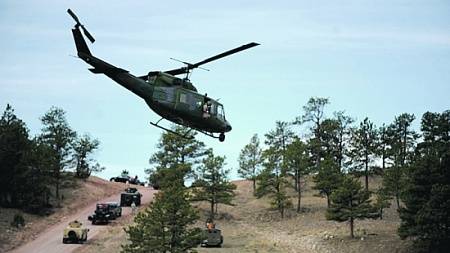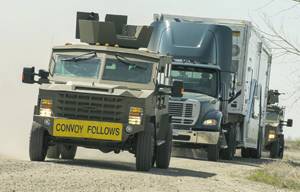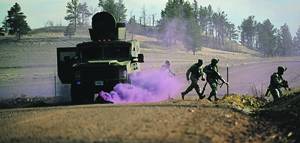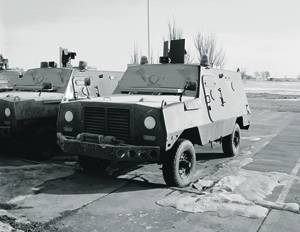Huey, Peacemaker, and Bullies
 According to the nature of the tasks, one of the most important specialized groups of each missile air wing, which is part of the 20 air army of the Command of the global strikes of the United States Air Force (KSU US Air Force) and armed with intercontinental ballistic missiles like "Minuteman III", is a security team ( Missile Security Forces Group). It is on the personnel of these groups that the very difficult task of physically protecting all components of the wing, primarily command posts and positional areas of intercontinental ballistic missiles (ICBM), as well as special trains with missiles in all sectors and their routes, lies.
According to the nature of the tasks, one of the most important specialized groups of each missile air wing, which is part of the 20 air army of the Command of the global strikes of the United States Air Force (KSU US Air Force) and armed with intercontinental ballistic missiles like "Minuteman III", is a security team ( Missile Security Forces Group). It is on the personnel of these groups that the very difficult task of physically protecting all components of the wing, primarily command posts and positional areas of intercontinental ballistic missiles (ICBM), as well as special trains with missiles in all sectors and their routes, lies.The complexity of this task is caused not only by the fact that the personnel of this group need to ensure safety from the whole spectrum of existing threats to the military air base itself, where the missile wing is deployed, as well as dozens of objects of its control system (missile launch control points, launch vehicle maintenance objects). positions, etc.) and one and a half hundred mine launchers of a separate start, but also by the fact that all the specified objects of each of the 20 air forces of the KSU US Air Force are wings intercontinental ballistic missiles scattered over a vast territory - about 25-34 thousand sq. m. km
In this regard, a convoy (special train) that delivers an intercontinental ballistic missile for installation in a silo launcher of a separate launch (FPS OS) or takes it to the arsenal is a particularly impressive sight. The convoy includes both the actual transport-loading vehicle with a rocket, as well as numerous armored guards, as well as the vehicle of the federal marshal. There is also a cover on top - a Huey helicopter with a group of military personnel, as well as other security teams. According to some estimates, the convoy personnel accompanying one ICBM are armed with a total of up to 60 machine guns of various types and caliber.
 To solve the tasks assigned to them, the units of the security group are armed like a regular rifle, aviation (helicopters) and other weapons that are supplied by the US Ground Forces and the Air Force, as well as a number of specialized weapons, military and special equipment, including specially modified UH-1N Huey Helicopters (UH-1N Huey Security Helicopter), as well as several modified high-mobility vehicles HMMWV (High Mobility Multipurpose Wheeled Vehicle), often referred to as "Humvee" (Humvee), and military vehicles guard "Piskiper" (Peacekeeper or PK), which is translated from English as "Peacekeeper" , and more recently, Biarkat (BearCat). The last name can be translated as "Bully" or "Drachun", but in fact it is a stylized abbreviation for the full name of this machine.
To solve the tasks assigned to them, the units of the security group are armed like a regular rifle, aviation (helicopters) and other weapons that are supplied by the US Ground Forces and the Air Force, as well as a number of specialized weapons, military and special equipment, including specially modified UH-1N Huey Helicopters (UH-1N Huey Security Helicopter), as well as several modified high-mobility vehicles HMMWV (High Mobility Multipurpose Wheeled Vehicle), often referred to as "Humvee" (Humvee), and military vehicles guard "Piskiper" (Peacekeeper or PK), which is translated from English as "Peacekeeper" , and more recently, Biarkat (BearCat). The last name can be translated as "Bully" or "Drachun", but in fact it is a stylized abbreviation for the full name of this machine.COMBAT PROTECTION MACHINES
The Peacekeeper combat vehicle is a Commando Ranger car with the 4x4 wheel formula, which was produced at the end of 1970-x, the beginning of 1980-s by Cadillac-Cage from New Orleans, Louisiana, based on a commercial vehicle The Chrysler Dodge 200 or Dodge Ram pickup truck, whose wheelbase was somewhat shortened, was equipped with an armored case that provided protection against 7,62 mm caliber armor-piercing bullets (although in fairness it should be noted that the American military The people who exploited the armored vehicle data believed that their booking was not enough to stop the 7,62 mm caliber bullet, as the developers and the command assured them, but they didn’t have to check it in practice, and also equipped with a turret , in which they installed a machine gun M60 caliber 7,62 mm, which had a circular sector of fire. Application of personal weapons the servicemen were provided with loopholes on board the vehicles.
This special vehicle was developed under the requirements of the United States Air Force for an inexpensive military armored guard vehicle (Security Police Armored Response /
 Convoy Truck), which was supposed to have high speed when driving on the highway, but at the same time to have the qualities of an SUV. After exploring various options, US Air Force experts at the beginning of 1979 of the year chose Commando Ranger. In the end, this special vehicle was produced in the interests of the military police and the security services of the Ground Forces, Navy, Marine Corps and the United States Air Force, where it received the new designation "Pikiper."
Convoy Truck), which was supposed to have high speed when driving on the highway, but at the same time to have the qualities of an SUV. After exploring various options, US Air Force experts at the beginning of 1979 of the year chose Commando Ranger. In the end, this special vehicle was produced in the interests of the military police and the security services of the Ground Forces, Navy, Marine Corps and the United States Air Force, where it received the new designation "Pikiper."Serial production of the machine was started in 1979. He officially entered the supply of units of the US Armed Forces in 1980 and was in operation until the end of the 1990s. The first Piskipper security vehicle was delivered to the customer in April 1980, and by the beginning of 1981, there were 560 such vehicles in the security and security services of the US Air Force and Navy. Note that the US Air Force became the largest customer of this machine, and in the American navy vehicles that retained, as in the United States ILC, their original designation “Commando Ranger,” were used as part of convoys that transported sea-based ballistic missiles (SLBMs) and their warheads from arsenals to submarines and vice versa. Moreover, a significant part of the vehicles belonging to the US Navy, served by the Marines.
According to David Howe, the author of the Wheeled Combat Machines, a total of up to 1994 were contracted with various types of US forces 708 machines of the Commando Ranger / Peacekeeper family, of which the US Air Force had an 571 machine, the purchase price of which was 30 532 dollars per unit. In 1996, a number of vehicles of this type remaining in the US Navy and KMP guard units were transferred to Bosnia, where they entered into service units of the peacekeeping forces operating under the auspices of the NATO (Implementation Force - IFOR) unit. Until the end of the 1990-s, all combat vehicles of this type of guard were written off. Deactivated vehicles of the US Armed Forces were transferred to special police force support units (SWAT) in different cities of the United States, and also delivered to Indonesia (at the end of the 1980-s no less than 20 machines were delivered here), Luxembourg and the Philippines.
The combatant security machine Piskiper (“Commando Ranger”) had the following tactical and technical characteristics: combat weight - 4903 kg, maximum length - 5030 mm, maximum width - 2640 mm, height - 2030 mm, wheel base - 203 mm, track width - 2640 mm, fuel capacity - 1689 l, speed - 121 miles / h (70 km / h), power reserve - 113 miles (300 km), obstacles to overcome - maximum gradient in 483%, ditch ( ditch) width 60 mm and wall height 710 mm.
The engine is a petrol eight-cylinder horsepower 180. (133 kW) at 3600 rpm (the engine was located at the front and had liquid cooling); Transmission - automatic; there was a gearbox with three gears forward and one back and a two-speed transfer case; rear suspension - spring; steering system - with power steering and front axle; double suspension hydraulic shock absorbers are used in both suspensions; electrical system - 12В.
 Armament - 7,62 mm machine gun М60 (1000 ammunition of cartridges) and personal weapons of military personnel. Night vision devices are individual, protection against weapons of mass destruction (WMD) is also individual.
Armament - 7,62 mm machine gun М60 (1000 ammunition of cartridges) and personal weapons of military personnel. Night vision devices are individual, protection against weapons of mass destruction (WMD) is also individual.Capacity in various options - 3 man of the crew and 6 – 8 security man (placement along the sides facing each other), landing through the rear double door. There were loopholes in both doors, and in the left casement there was also a periscope observation device. In the variant of the Peacekeeper security vehicle of the security (security) units of the US Air Force missile wings, the crew included only four servicemen: the vehicle commander is the driver, the gunner is the machine gunner’s assistant, the machine-gunner and the gunner (gunner). The first two soldiers were located on the front seats face down the vehicle, the machine gunner was immediately behind the driver, and the remaining gunner was in the back of the car (the last two were facing the opposite side).
Subsequently, Cadillac Cage also developed an upgraded version of this car, which was created on the basis of Ford’s F-350 car and was designated Peacekeeper II (PeaceKeeper II). However, not a single vehicle of this type was ordered, so the Psikiper II was not put into mass production, and the Barykat armored combat vehicles came to the corresponding units of the US Air Force to replace the Pikiper guard combat vehicles.
NEW DEVELOPMENT
The combat vehicle “Biarket” was developed by Lenko Industries, a Michigan company, based on Ford’s Super Duty F-550, and is a slightly smaller version of a larger Biar armored vehicle (BEAR). Its very interesting short name, consonant with the English name "binturong" or "cat's bear" (mammal of the weaver family), received from the full name of this development Ballistic Engineered Armored Response Counter Attack Truck, which can be translated from English as "armored vehicle protection with protection against small arms ". It is noteworthy that in a number of sources the name "Biarket" is somehow associated with the Chinese name of the panda, which is said to consist of hieroglyphs "bear" ("biar") and "cat" ("cat").
The main tactical and technical characteristics of this vehicle are as follows: the combat weight is 7960 kg, the greatest length is 6096 mm, the greatest width is 3048 mm, the maximum height is 3658 mm, the maximum speed of the highway is 140 km / h. The engine is a turbo diesel brand “Caterpillar” with 360 horsepower, although the V10 “Triton” gasoline engine of comparable power can be used. Transmission - automatic, six-speed. Capacity - 2 crew member and up to 10 security group man.
Armament - 7,62 mm М60 machine gun on the turret in the turret on the cab roof, or, if necessary, other weapons in the same place (for example, automatic grenade launcher), as well as personal firearms of the security unit’s soldiers, fired from through special slits in the vehicle body. The armored vehicle also has various specialized equipment, including special sirens; hinged roof; Common Remotely Operated Weapon Station (CROWS); tear gas spraying device, etc .; loopholes for firing personal weapons; electric winch; special footboards; protection against chemical, biological, radioactive, nuclear and explosive substances (CBRNE); Rear View Camera; radiation detectors, thermal imagers, etc .; place for mounting a special ram, etc.
The developer specifically points to the explosion-proof performance of this family of armored vehicles, which is provided by constructive solutions and the use of various armor materials and allows you to protect the personnel in the car from small arms, improvised explosive devices, etc. Car booking is NIJ Type IV standard, that is, the fourth, the highest, class of protection in accordance with the standard of the National Institute of Justice of the United States. In this case, the armored vehicle is protected from 0,30 caliber armor-piercing bullets (7,62 mm) with a nominal mass of 10,8 g and a minimum speed when hitting no more than 869 m / s. Structurally, the reservation is provided with steel plates 0,5 inch thick (127 mm), and according to some information - steel plates up to 1,5 inch thick (38,1 mm). In a number of sources it is also indicated that the glazing used in this car allows to withstand repeated hits of bullets of caliber 12,7 mm.
The American press cites a case that took place in Texas in 2010 and confirmed the developer’s specifications for the machine’s security: the offender shot a full horn from the Kalashnikov assault rifle according to Biarket, but none of the bullets penetrated inside the car. Other similar cases have also been recorded - invariably without loss by the police.
The development of this armored vehicle was generally completed in 1999 – 2000, and in August 2001, the first vehicle was fully assembled and began to be tested. The design work on this armored vehicle was attended by employees of a special unit of the Los Angeles County Sheriff's Department. At present, there are nine different versions of the armored vehicle "Biarket", one of which - the so-called military version (Military) - is in service with the units of the US Air Force missile wings. There are also armored vehicles for diplomatic services, sapper and medical evacuation vehicles, plus a number of police cars in various versions.
The US Air Force purchased a total of at least 60 combat vehicles of this type, which came to the security units of missile wings, armed with intercontinental ballistic missiles such as "Minuteman" III. These machines in various modifications, in addition, entered the supply of power support units of the American police (SWAT), as well as private military companies and security services in the United States and in several countries around the world, such as Australia, Brazil, Holland, Canada and Morocco. The purchase price of one machine, depending on the configuration, ranges from 188 793 to 300 thousand dollars.
Information